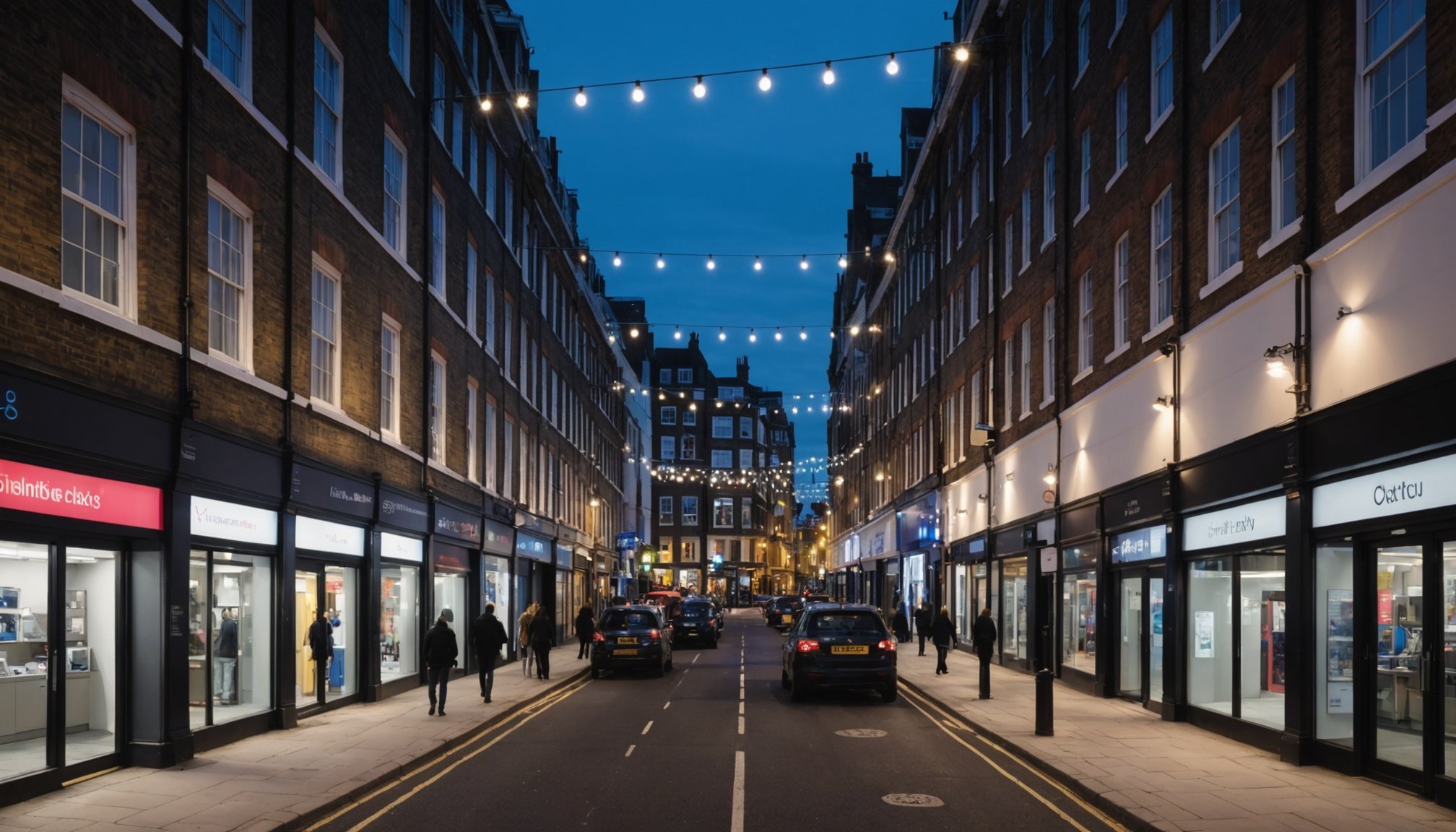Overview of Intelligent Lighting Solutions
Intelligent lighting is revolutionising urban environments with smart technologies that redefine how cities illuminate their streets. These systems integrate sensors, data analytics, and adaptable components to optimise lighting based on real-time conditions. By converting traditional lighting into automated frameworks, intelligent lighting enhances energy use and urban appeal.
Smart technologies in lighting are rapidly advancing. From dynamic dimming features to adapting lights according to pedestrian traffic, these innovations are increasingly prevalent in urban areas. Up-and-coming trends include the incorporation of IoT devices and AI-driven controls, which allow for highly personalised and efficient lighting management.
This might interest you : Tailored arabic lessons: your path to fluency online
In the UK, adapting lighting to meet evolving urban needs remains a crucial focus. As cities grow, properly implemented smart lighting solutions support infrastructure, offering tailored illumination that promotes safety and environmental sustainability. This is particularly important in urban environments where pedestrian and vehicle activity fluctuate throughout the day. Intelligent lighting optimally directs light and can reduce waste and nuisance lighting, benefiting both the community and the ecological landscape.
By addressing these needs, intelligent lighting serves as a cornerstone for urban development, aligning with sustainability efforts and enhancing overall quality of life in city settings.
This might interest you : Embrace tomorrow: explore cutting-edge innovations in home renewable energy solutions
Energy Efficiency Benefits
In urban environments, intelligent lighting provides substantial energy efficiency advantages by optimising energy use and promoting sustainable lighting practices. These systems intelligently adapt lighting levels in response to real-time conditions, minimizing energy waste. This adaptability not only reduces the overall energy consumption but also contributes significantly towards lowering the carbon footprint associated with traditional lighting infrastructure. Through targeted light distribution and advanced dimming capabilities, intelligent lighting ensures that illumination is provided only when and where it is required.
The financial implications for municipalities and businesses are equally noteworthy. By enhancing efficiency, intelligent lighting contributes to long-term cost savings by reducing energy expenditure. Integrating renewable energy sources, such as solar panels, with smart lighting systems further bolsters these savings. These renewable sources decrease reliance on fossil fuels, offering an environmentally friendly alternative to electricity sourcing.
Adopting intelligent lighting also aligns with global sustainability goals by integrating emerging green technologies into urban planning and development. As more cities prioritise sustainable lighting, the adoption rate of smart technologies increases, fostering an ecosystem that promotes both economic advantage and environmental stewardship. The shift towards energy-efficient lighting solutions illustrates a commitment to responsible urban management and climate action.
Safety Improvements
Within urban environments, intelligent lighting plays a crucial role in enhancing safety and security. By strategically illuminating areas, these systems can deter criminal activities, making cities safer for residents and visitors. In several case studies, improved lighting has shown to be effective in reducing crime rates, specifically in poorly lit areas, which often act as hotspots for unlawful activities. For instance, after-installation analytics in certain cities revealed notable declines in incidents like theft and vandalism, underscoring the powerful deterrent effect of well-lit environments.
Public perception of safety is another vital aspect addressed by smart technologies in lighting. When urban areas are adequately illuminated, people naturally feel safer and more secure, fostering a sense of community and enhancing social interactions. This heightened sense of security enhances the quality of life within cities, encouraging more pedestrian activities during dusk and nighttime.
Smart lighting systems provide adaptable solutions, adjusting to urban environments and focusing light precisely where it’s needed most. This adaptability maximises efficiency while minimising unnecessary light pollution, ensuring heightened urban safety without compromising environmental integrity. Through these intelligent innovations, cities are better equipped to tackle safety challenges and provide secure, welcoming environments for all.
Enhancing Urban Aesthetics
Intelligent lighting contributes significantly to the overall aesthetic of urban environments by integrating functionality with visual appeal. Through the application of smart technologies, cities can illuminate spaces in a way that enhances architectural features and transforms public areas into visually pleasing landscapes. Well-designed lighting can highlight historical landmarks, cultural sites, and modern infrastructures, creating an attractive night-time ambiance.
Several cities have successfully adopted smart lighting to revitalise their urban scenery. For instance, London’s West End uses adaptive lighting systems to create a dynamic atmosphere, attracting tourists and enhancing local nightlife. Similarly, Glasgow has implemented smart lighting to illuminate its Victorian architecture, blending technological innovation with traditional charm.
Balancing functionality with beauty is crucial in urban lighting design, ensuring areas are both safe and aesthetically engaging. Adaptive light fixtures can adjust colour, intensity, and direction to suit different environments and events, providing tailored solutions that meet both practical needs and artistic aspirations. As more urban areas embrace intelligent lighting, the opportunity arises to create spaces that are not only well-lit but also visually captivating, promoting a unique and bustling city life.
Sustainability and Environmental Considerations
Sustainability in urban environments is significantly boosted by the adoption of intelligent lighting, which aligns with global efforts to reduce environmental impact. These systems integrate green technologies to create efficient, eco-friendly illumination solutions. By harnessing the power of sensors, data analytics, and IoT devices, intelligent lighting reduces energy consumption, thereby decreasing the carbon footprint of urban areas.
Urban sustainability initiatives benefit from such innovative approaches. For instance, smart lighting can operate on renewable energy sources like solar panels or wind turbines, cutting reliance on fossil fuels. Beyond just energy savings, this also diminishes the emission of harmful pollutants. Cities are now facing the challenge of balancing environmentally-friendly urban planning with technological advancements. Implementing adaptive and responsive lighting systems involves logistical hurdles, yet these are essential for achieving sustainable development goals.
Key to successful integration is overcoming the financial and technical barriers. Increasing investments in eco-friendly technologies and developing partnerships with stakeholders can drive progress. Moreover, educating the public on the environmental benefits of smart lighting encourages widespread adoption. By prioritising sustainability, cities ensure cleaner and healthier urban living spaces.
Case Studies from UK Cities
Intelligent lighting has successfully transformed several UK cities through innovative application and strategic planning. These case studies reveal how smart technologies were harnessed to enhance urban infrastructure.
In Bristol, a comprehensive adoption of intelligent lighting has led to notable improvements in energy efficiency and urban safety. The city reported a decline in energy consumption by integrating adaptive lighting that adjusts to real-time data, reducing costs and benefitting the environment.
Glasgow provides another compelling example, where smart lighting systems were installed to highlight the city’s cultural landmarks. This not only improved urban design but also boosted tourism by creating an inviting atmosphere. The city’s successful deployment serves as a blueprint for merging lighting aesthetics with practical urban needs.
Key performance indicators from these implementations underline the substantial energy savings and heightened public safety achieved. Community feedback has been largely positive, showing increased acceptance and appreciation for smart lighting solutions.
These case studies demonstrate the potential of intelligent lighting to meet urban demands while delivering economic and environmental benefits. They offer valuable insights for future projects, emphasizing the importance of planning, community engagement, and flexibility in technology use.
Challenges in Implementation
Incorporating intelligent lighting into urban infrastructure presents several implementation challenges. One prominent challenge is public resistance, which often stems from misunderstanding or concern over privacy and aesthetics. To overcome this, urban planners and stakeholders need to prioritise community engagement. Engaging residents through informational sessions and participatory planning can help address concerns and gain public support.
Technical hurdles also pose significant obstacles in the integration process. These can include issues like system compatibility, data integration, and maintenance needs. Solutions to these technical challenges are multi-faceted. For instance, ensuring robust training for technicians and adopting flexible, scalable technologies can mitigate compatibility issues. High-quality data management systems are crucial in overcoming integration barriers, providing reliable results and ensuring the longevity of smart technologies.
Additionally, collaboration with technology providers is essential to troubleshoot and refine implementation strategies. Urban areas can benefit from leveraging partnerships to access cutting-edge technology and expertise. By proactively addressing these challenges, cities can effectively utilise intelligent lighting to enhance urban environments, creating a sustainable and appealing infrastructure that aligns with modern needs.
Future Trends in Intelligent Lighting
The future of intelligent lighting is closely tied to smart city development, where urban spaces become more interconnected through advanced technologies. Emerging trends such as AI-driven controls and the integration of IoT devices are set to make lighting systems more adaptive and personalised. These advancements will enable urban environments to automatically adjust lighting based on occupancy, weather conditions, and time of day, significantly enhancing their efficiency and functionality.
One of the primary technological advancements expected is the implementation of machine learning algorithms in lighting systems. These systems can analyse patterns and predict optimal lighting configurations, thus optimising energy consumption and improving user experience. Additionally, the development of hybrid lighting solutions that combine solar power with traditional electricity sources is gaining momentum, offering a sustainable alternative to traditional lamps.
Importantly, the role of intelligent lighting in smart city initiatives goes beyond mere energy savings. It encompasses enhancements in urban safety, traffic management, and environmental monitoring. The ability to seamlessly integrate with third-party smart systems will further drive innovations in this field. As cities continue to evolve, future trends in intelligent lighting will likely prioritise versatility, eco-friendliness, and user-centric designs, paving the way for next-generation urban living.











